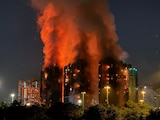The air at the edge of the Kushak Drain in Defence Colony is a rancid blend of rotting sewage, stagnant water, and chemical effluents that burns the throat and stings the eyes. Dark clouds gather overhead, unleashing a sudden drizzle that slicks the ground and intensifies the stench.
The once-vital stormwater channel, now a de facto sewer, churns with viscous black sludge, its surface rippling under the first raindrops.
Five JCB excavators rumble along the drain's edge, as they claw out heaps of wet, glistening silt. Below, in the drain's shadowed depths, labourers toil, as they descend into the open sections without safety gear, no masks, no gloves, no harnesses to dislodge sewage caked like ancient roots.
Ramesh, a wiry labourer in a rain-soaked vest, told NDTV, "I've been here since March. This drain's been ignored for years, maybe decades. The silt's hard as cement. Historic inaction, you know? Everything's built up: sewage, garbage, chemicals. The rain makes it tougher-slippery, messier. But we're pushing. They say 10 days, and it'll be cleared".
With the monsoon set to hit Delhi between June 19 and 25, the Public Works Department (PWD) has missed its second deadline for desilting the city's 2,140.91 km of drains, with only 60.47% cleared as of Monday, according to the department's latest report.
After failing to meet the May 30 target and the revised June 15 deadline, the PWD now aims for June 30, leaving major drains like Shahdara Road (72.92% desilted), East Road (62.25%), and North Road (52.66%) dangerously clogged. This delay, coupled with the unresolved crisis of the Kushak Drain - a stormwater channel turned toxic sewer - signals another season of flooding, health risks, and bureaucratic failure.
The Kushak Drain, snaking through upscale neighborhoods like Defence Colony, Greater Kailash-1, and Chirag Delhi, exemplifies Delhi's drainage woes. Covered with concrete slabs in a flawed 2009 project, it traps sewage, industrial effluents, and silt, transforming a vital stormwater channel into a public health hazard and a major polluter of the Yamuna River. Desilting alone cannot fix the underlying issue: the concrete covers prevent proper inspection and maintenance, perpetuating a cycle of flooding and environmental degradation.
As the National Green Tribunal (NGT) deadline for desilting the drain's covered sections passed in April 2025 with only 66% completion, residents are left grappling with toxic fumes, mosquito infestations, and the looming threat of monsoon chaos.
A City on the Brink
Delhi's monsoons annually bring utter chaos: submerged streets, stranded commuters, and homes flooded with toxic sludge. The PWD's failure to remove the targeted 2.26 lakh metric tonnes of silt-having cleared just 23,190 MT recently leaves areas like Mehrauli, Okhla, and Shahdara particularly vulnerable.
Chief Minister Rekha Gupta's promise of a waterlogging-free Delhi remains unfulfilled, with only 35-43% of the city's overall desilting complete as the monsoon approaches.
The Kushak Drain's plight is particularly dire.
"Covering a stormwater drain was a catastrophic mistake," says Bhavreen Kandhari , a local environmentalist. "It blocks inspection and desilting, turning it into a toxic cesspool." The concrete slabs, installed to mask odours and create parking spaces, have instead trapped pollutants, releasing hydrogen sulfide and methane gases that cause respiratory illnesses and corrode appliances.
The drain's untreated sewage flows directly into the Yamuna, with Delhi's 2% stretch of the river accounting for 80% of its pollution, according to experts.
A Decade of Neglect
The NGT has repeatedly intervened, ordering municipal bodies to stop covering stormwater drains and restore their natural flow, as seen in landmark cases like the 2015 Manoj Mishra and Madhu Bhaduri petition and the 2023 Pamari drain case. Yet, enforcement remains weak. The Municipal Corporation of Delhi (MCD) and the Irrigation and Flood Control Department (I&FCD) have faced criticism for their inaction, with the Kushak Drain's covered sections only 66% desilted as of May 22, 2025. A brief cleanup push last August, spurred by the Lieutenant Governor, offered temporary relief but lacked follow-through.
Residents like Priya Sharma, who has petitioned courts since 2015, are furious. "We're choking on apathy," she says. "The stench is unbearable, and the health risks are real." Jas Bhatia, a Defence Colony resident, adds, "The toxic fumes invade our homes. My daughters want us to move out. Even our appliances rust within months."
Environmental litigant Rajeev Suri, who has fought the drain's covering for over a decade, told NDTV it exemplifies "poor environmental governance," violating the Water (Prevention and Control of Pollution) Act, 1974, and disrupting the drain's role in groundwater recharge and flood prevention.
A Race Against Time
With the monsoon expected by June 27-28, logistical challenges -improper silt disposal and dependency on adjoining drains - make Minister Parvesh Verma's June 15 citywide desilting target unattainable.
A Rs 7.3 crore culvert bridge project at Ratan Lal Sahdev Marg, aimed at easing drainage and traffic issues, won't be completed until March 2026, offering little immediate relief.
Mr Kandari emphasises the need to uncover the drain entirely: "The covers must be removed, sewage inflow stopped, and a strict maintenance schedule enforced."
As rainclouds gather, the Kushak Drain stands as a stark warning.
Without urgent action to uncover and clean it, Delhi faces another season of floods, toxic fumes, and broken promises.















